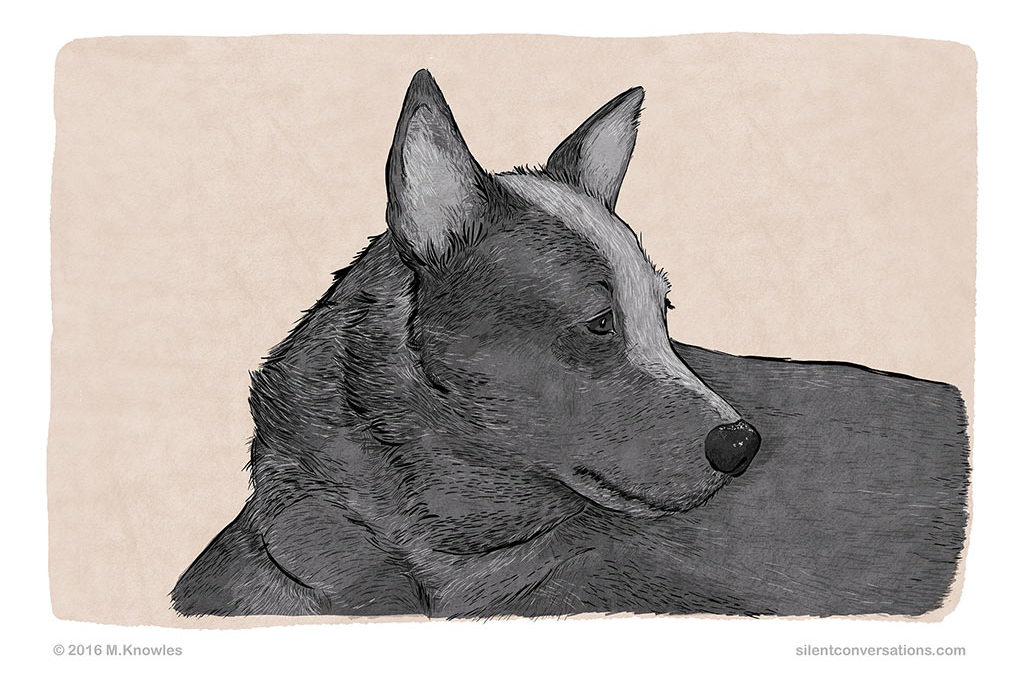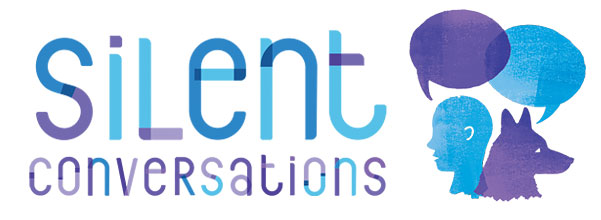
Head Turn – Dog Body Language
Head Turn – Dog Body Language
A head turn can be overt, where the dog turns her head to the side fully, or at other times it can be subtle, with a slight turning of the head or averting of gaze. The head turn can be used as a polite gesture to communicate goodwill in a greeting between two dogs. In other circumstances, a head turn and averting of gaze can be seen as a gesture by the dog to calm a situation down and indicate that there is no threat. Direct gaze can be seen as threatening, or when used with a freeze (at times the freeze can be ever so slight and quick), is seen as a warning to the other party in dog body communication terms. Depending on the context, the head turn could also be used as a calming signal to show discomfort or to communicate that the individual does not wish to continue the interaction.
Here are a few examples of situations where a dog may offer a head turn:
- Dogs very commonly give head turns when you are trying to take a photo of them. I am sure many dog guardians have experienced this and been frustrated by the difficulty of trying to get a photo of their dog looking directly into the camera. The head turn may be offered as a calming signal, as the dog may be feeling uncomfortable about you looming over him in a front-on stance, giving focused attention while you have a weird device in your hand.
- A young pup approaches an adult dog. Being a pup, she approaches a bit excitedly and in a wiggly manner, jumping up and mouthing at the adult dog’s face. The adult dog freezes with his ears pushed a bit to the side, his mouth closed and his body slightly stiffened, and he does a head turn. In this instance, the adult dog is using the head turn as a calming signal and is communicating that he would prefer a calmer polite approach. It is vital for young dogs to learn and listen to these signals to hone polite communication skills as they mature.
Depending on his tolerance and patience and the situation he is placed in, the adult dog may use louder language if the head turn is ignored. He might turn his whole body or his back towards the pup or walk away to calmly communicate with the pup. If his patience is pushed, there could be a quick moment of direct eye contact as a warning, a lip curl and then maybe a reprimand like a growl or snap. Sometimes this eye contact is given together with a slight head turn; you will see a freeze, and even though the head is turned away ever so slightly, the eyes will turn towards the pup, creating what is termed whale eye – showing the whites of the eye.
- Two unknown dogs meet for the first time and show slight curves in their bodies (shoulders ever so slightly curved away from each other), ears slightly up a little to the side, soft, almond-shaped eyes, and tails wagging a little bit fast (at just above back line). Both of the dogs do head turns in quick succession, avoiding eye contact, and then slowly curve round each other to sniff behind. Then they slowly move away from each other and sniff the ground nearby. The head turns in this instance are not necessarily intended to end the interaction but rather indicate that the dogs are negotiating a peaceful greeting. Although both may be a bit unsure of each other, as revealed by the ears being up, the fast movements of the tails and the head turns, the dogs are trying to be very courteous with one another while showing a hint of trepidation. (Please note for dog to dog greetings – look at the context and complete body language. Interpretation may vary depending on context).
- One dog is lying on the ground chewing something tasty, and another dog wishes to pass him. The dog that is passing has a bit of distance and slowly comes nearer to the dog lying on the ground. This dog stops chewing, freezes over the item and gives a moment of direct eye contact to the approaching dog. The dog that is trying to pass now stops a slight distance away, sits down and starts offering head turns, averting the gaze of the other dog. In this instance, the approaching dog is offering the head turn as a calming signal to say that he is no threat and does not wish for any conflict.
- Two dogs are asked to sit in close proximity to each other in a dog obedience class. Both the dogs sit and seem to be avoiding any direct eye contact with each other by turning their heads in opposite directions from each other. This may look like the dogs are not communicating, but they are actually saying a lot. Both dogs feel uncomfortable being placed in this awkward social situation with another unknown party and are trying to use the head turn as a calming signal communicating they wish no harm and do not wish to interact.
- A person leans over a dog to pet him. The dog does a head turn then a lip lick. The dog is using the head turn as a calming signal communicating that he is not comfortable and would prefer a hands-off greeting.
These are just a few examples; there may be many more. Start observing to see if you can notice any head turns in different contexts. As discussed below, interpretations such as the above examples should not be attempted without careful observation and consideration of all aspects of the situation.
A few notes to consider when observing dog body language:
Observation before interpretation
Interpretations should be offered only once you have observed the complete interaction and taken note of the wider picture. To offer an unbiased interpretation of the body language, observe and take note of the situation, taking into account the dog’s whole body, the body language signals, and environment first before offering an interpretation. List all the body language you see in the order that it occurs; try to be as descriptive as possible without adding any emotional language. For instance, saying a dog looks happy is not descriptive and would be seen as an interpretation rather than an observation.
You could, however, list what you observe: ears to the side, eyes almond shaped, slight shortening of the eye, mouth open, long lips, tongue out, body moving loosely, body facing side-on, tail wagging at a slow even pace at body level.
From the observation, I could interpret that the dog seems relaxed or comfortable. I still prefer to say relaxed rather than happy, as I feel you will truly never know exactly what the dog may be feeling on the inside emotionally. It is quite likely the dog may be feeling happy, but I prefer to comment on how the dog is behaving in response to the situation rather than presuming internal emotional states.
The importance of viewing body language within context
Interpretations can vary depending on the context. It is possible for certain body language to be used in different contexts and have subtle differences in meaning within those contexts. Individual body language signals should not be observed in isolation; the wider picture should be considered. Take note of what the dog’s body as a whole is saying. Keep in mind each dog is an individual with varying skills and experiences. What may be typical for one individual may not be for another. In order to observe body language in context, consider the following: the situation, body language signals, the body language expressed by all parts of the dog’s body, environment, and individuals involved. It is worth noting how the body language changes with feedback from the environment or the other individuals interacting.

Martha Knowles
Author
My vision is to create a community of dog guardians who share their observations and interpretations of their dogs’ silent conversations. Hopefully, these experiences and stories will provide some insight into dog communication, which is often overlooked by the untrained eye because it is unfamiliar to humans. We are accustomed to communicating mainly with sound, so we are not attuned to the silent subtle gestures and body language used by dogs to communicate. If you take the time to observe, you will start to see these 'silent conversations' going on around you. My dream is for dog communication to become common knowledge with all dog guardians and as many people as possible. Surprisingly, there are still some professionals working in various dog-related careers who are uneducated about dog body language. Greater awareness of how dogs communicate will help to provide better understanding and improve the mutual relationship between dogs and humans. This will promote safer interactions between our two species and hopefully remove some of the expectations placed on dogs within human society. I would like dog guardians to feel empowered with their knowledge of dog communication so that they can be their dogs’ advocates and stand up for themselves and their dogs when it really matters.



